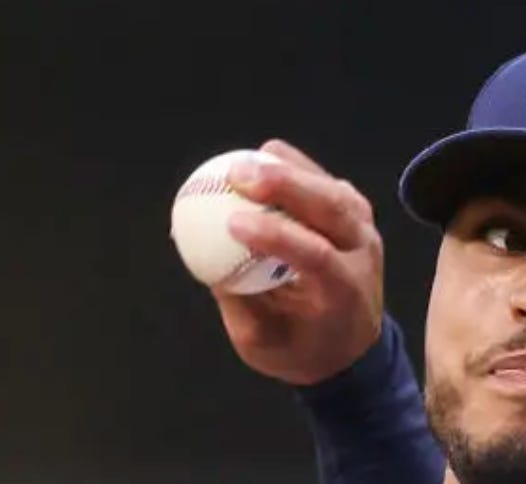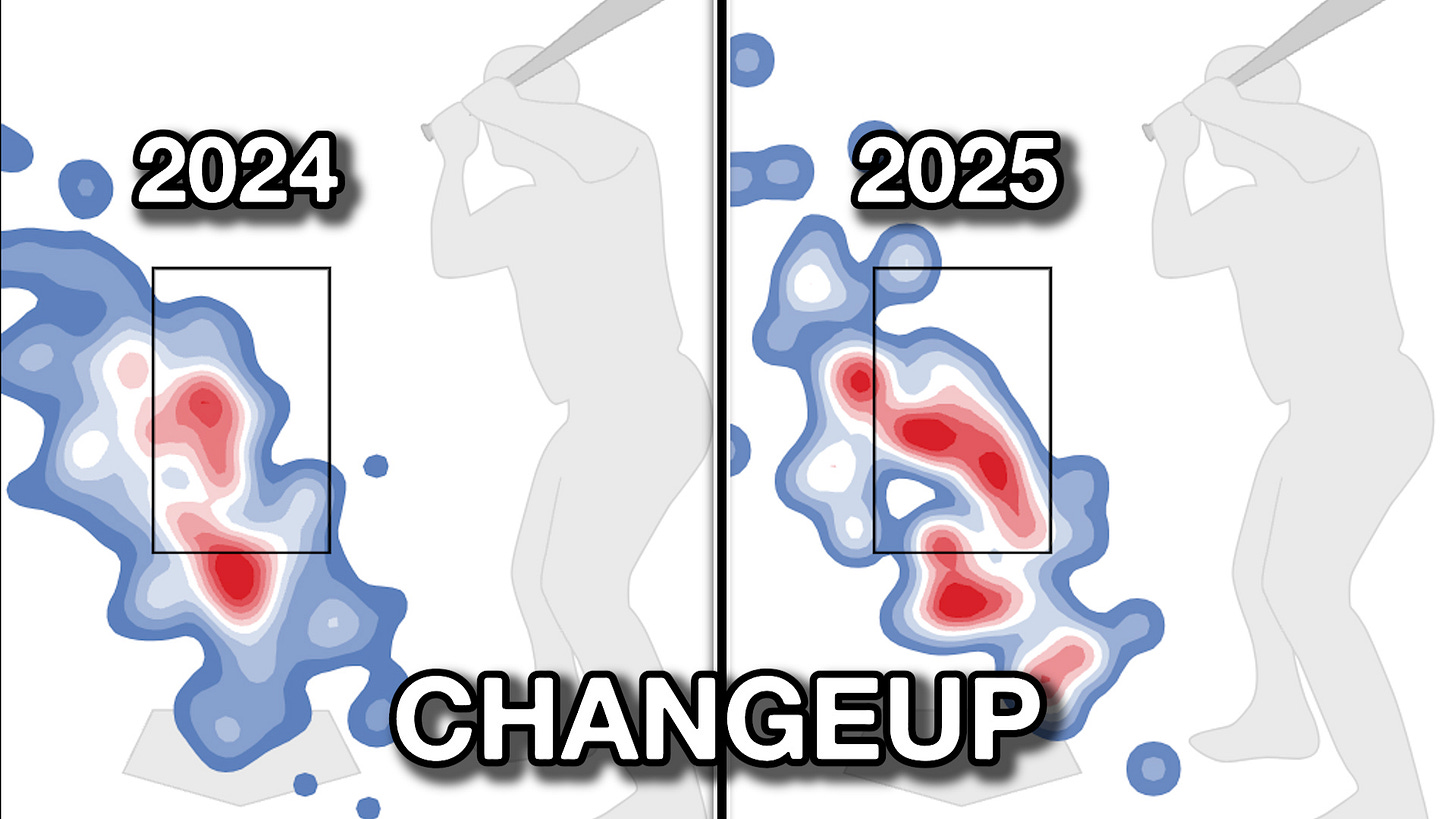Taj Bradley's New Sinker. Jacob Misiorowski's Electric Debut
Taj Bradley, Jacob Misiorowski, Keider Montero
Rays Taj Bradley has a new sinker (4 IP, 4 H, 5 R, 0 ER, 4 BB, 5 K yesterday). It’s a very similar shape to his four-seam fastball, with 2” less vertical break (more drop) and 3” more arm-side movement (grip below). He added this earlier in the season, but started pushing usage up in mid-May. Over his last 6 starts, he’s throwing it 31% to right-handed hitters. Although the shape isn’t notably different from his four-seam fastball, the location is. The sinker is hard inside, and its usage peaks in the first or second pitch of an at-bat (alongside some two-strike usage). This moved the average location of his four-seamer more up-and-away to righties. His ground-ball rate is up to 52% against (from ~33%), and he’s cut his xFIP from 4.83 across his first 8 starts to 3.63 over his last 6 against that handedness. High spin efficiency types like this usually aren’t given sinkers, but between Chris Paddack and now Bradley, it seems like those tides could be changing? ☀️
Bradley still has some lefty issues because he can only strike his four-seamer and doesn’t appear to trust his cutter more than as an early count strike stealer. This has led him to use his splitter more across this 6-start stretch. Given he can zone it >50%, I like the idea. And with a 3.74 xFIP compared to an 8.68 ERA against lefties in that stretch, he’s due for some positive regression. He still needs a viable cutter, but for now, better days are ahead. Better than his ~4 ERA projections? That feels more aggressive than I’d be comfortable with.
Brewers Jacob Misiorowski went 5 IP, 4 BB, 5 K in his electric MLB debut. I’ll start with the curveball because it’s one of the more absurd pitches in MLB. It averaged 88 mph with -9” vertical break and 6” glove-side movement. The average curveball has around the same shape (~3” more glove-side movement) but is 7.5 mph slower. No other curveball thrown 20 or more times this season sits above 87 mph with more drop than -7.5” vertical break. Grant Taylor’s curveball averaged 86.5 mph with -14.5” vertical break in his debut (just 3 thrown), almost 50% more drop at a similar velocity to Misiorowski. We may have just seen two of the best-shaped curveballs in the Statcast era debut in a matter of 4 days. 🍺
The key variable defining Miz is his extension down the mound. He’s 6’7” with 7’6” extension. He’s releasing his fastball closer to home plate than 99% of MLB pitchers and sitting 99 mph, which is ~3 mph harder than anybody else with more than 7’5” extension. The closest comparison is Cade Smith, who extends 7’5” with a 96-mph four-seamer. All this and I haven’t talked about his cutter. It’s a pitch he developed late last season that has mostly solved his righty command issues that were the black mark on his profile as a prospect for years (more on that here). The net is still below-average command (it’ll work as an SP), but his stuff is what dreams are made of.
Tigers Keider Montero is a stock right-hander with average shapes and locations that the Tigers often use as a bulk guy. His peripherals are a bit off this year, with his strikeout rate falling from 19% to 15% and his walk rate slightly up. The encouraging angle is that he’s been better versus right-handed hitters. It’s likely tied to him using fewer four-seamers. And to make up for it, his sinker usage has increased from 22% in the second half of last season to 36% this season. His four-seamer has fallen back from 33% to 21% after allowing a .446 xwOBA on contact (average is .376). 🐅
Montero’s problem this year has been left-handed hitters. He’s posting a negative K-BB rate and a 10% barrel rate. He’s throwing a touch fewer four-seamers this season, but the primary issue seems to be damage against his changeup. This appears to be as simple as him pulling his changeup into the the body of left-handed hitters more than he did last season (see below). And to nobody’s surprise, this is where all four of his changeup barrels have been located.







